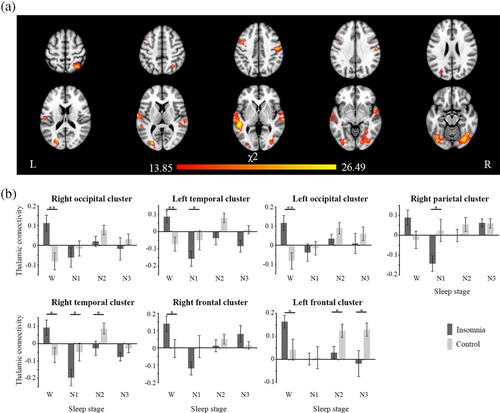当前位置:
X-MOL 学术
›
Hum. Brain Mapp.
›
论文详情
Our official English website, www.x-mol.net, welcomes your
feedback! (Note: you will need to create a separate account there.)
Altered thalamic connectivity in insomnia disorder during wakefulness and sleep
Human Brain Mapping ( IF 3.5 ) Pub Date : 2020-10-13 , DOI: 10.1002/hbm.25221 Guangyuan Zou 1, 2 , Yuezhen Li 3, 4 , Jiayi Liu 1, 2 , Shuqin Zhou 2 , Jing Xu 2, 5 , Lang Qin 2 , Yan Shao 3 , Ping Yao 6 , Hongqiang Sun 3 , Qihong Zou 2 , Jia-Hong Gao 1, 2, 7
Human Brain Mapping ( IF 3.5 ) Pub Date : 2020-10-13 , DOI: 10.1002/hbm.25221 Guangyuan Zou 1, 2 , Yuezhen Li 3, 4 , Jiayi Liu 1, 2 , Shuqin Zhou 2 , Jing Xu 2, 5 , Lang Qin 2 , Yan Shao 3 , Ping Yao 6 , Hongqiang Sun 3 , Qihong Zou 2 , Jia-Hong Gao 1, 2, 7
Affiliation

|
Insomnia disorder is the most common sleep disorder and has drawn increasing attention. Many studies have shown that hyperarousal plays a key role in the pathophysiology of insomnia disorder. However, the specific brain mechanisms underlying insomnia disorder remain unclear. To elucidate the neuropathophysiology of insomnia disorder, we investigated the brain functional networks of patients with insomnia disorder and healthy controls across the sleep–wake cycle. EEG‐fMRI data from 33 patients with insomnia disorder and 31 well‐matched healthy controls during wakefulness and nonrapid eye movement sleep, including N1, N2 and N3 stages, were analyzed. A medial and anterior thalamic region was selected as the seed considering its role in sleep–wake regulation. The functional connectivity between the thalamic seed and voxels across the brain was calculated. ANOVA with factors “group” and “stage” was performed on thalamus‐based functional connectivity. Correlations between the misperception index and altered functional connectivity were explored. A group‐by‐stage interaction was observed at widespread cortical regions. Regarding the main effect of group, patients with insomnia disorder demonstrated decreased thalamic connectivity with the left amygdala, parahippocampal gyrus, putamen, pallidum and hippocampus across wakefulness and all three nonrapid eye movement sleep stages. The thalamic connectivity in the subcortical cluster and the right temporal cluster in N1 was significantly correlated with the misperception index. This study demonstrated the brain functional basis in insomnia disorder and illustrated its relationship with sleep misperception, shedding new light on the brain mechanisms of insomnia disorder and indicating potential therapeutic targets for its treatment.
中文翻译:

觉醒和睡眠期间失眠障碍中丘脑连接的改变
失眠症是最常见的睡眠障碍,越来越受到关注。许多研究表明,过度觉醒在失眠障碍的病理生理学中起着关键作用。然而,失眠症的具体脑机制尚不清楚。为了阐明失眠症的神经病理生理学,我们研究了失眠症患者和健康对照者在整个睡眠-觉醒周期中的脑功能网络。分析了来自 33 名失眠症患者和 31 名匹配良好的健康对照者在清醒和非快速眼动睡眠期间(包括 N1、N2 和 N3 阶段)的 EEG-fMRI 数据。考虑到其在睡眠 - 觉醒调节中的作用,选择内侧和前丘脑区域作为种子。计算了丘脑种子和大脑体素之间的功能连接。对基于丘脑的功能连接进行带有“组”和“阶段”因子的方差分析。探索了误解指数和改变的功能连接之间的相关性。在广泛的皮层区域观察到了逐个阶段的相互作用。关于组的主要影响,失眠症患者在清醒和所有三个非快速眼动睡眠阶段表现出与左侧杏仁核、海马旁回、壳核、苍白球和海马的丘脑连接性降低。N1 皮层下簇和右侧颞叶簇的丘脑连通性与错觉指数显着相关。
更新日期:2020-12-08
中文翻译:

觉醒和睡眠期间失眠障碍中丘脑连接的改变
失眠症是最常见的睡眠障碍,越来越受到关注。许多研究表明,过度觉醒在失眠障碍的病理生理学中起着关键作用。然而,失眠症的具体脑机制尚不清楚。为了阐明失眠症的神经病理生理学,我们研究了失眠症患者和健康对照者在整个睡眠-觉醒周期中的脑功能网络。分析了来自 33 名失眠症患者和 31 名匹配良好的健康对照者在清醒和非快速眼动睡眠期间(包括 N1、N2 和 N3 阶段)的 EEG-fMRI 数据。考虑到其在睡眠 - 觉醒调节中的作用,选择内侧和前丘脑区域作为种子。计算了丘脑种子和大脑体素之间的功能连接。对基于丘脑的功能连接进行带有“组”和“阶段”因子的方差分析。探索了误解指数和改变的功能连接之间的相关性。在广泛的皮层区域观察到了逐个阶段的相互作用。关于组的主要影响,失眠症患者在清醒和所有三个非快速眼动睡眠阶段表现出与左侧杏仁核、海马旁回、壳核、苍白球和海马的丘脑连接性降低。N1 皮层下簇和右侧颞叶簇的丘脑连通性与错觉指数显着相关。











































 京公网安备 11010802027423号
京公网安备 11010802027423号